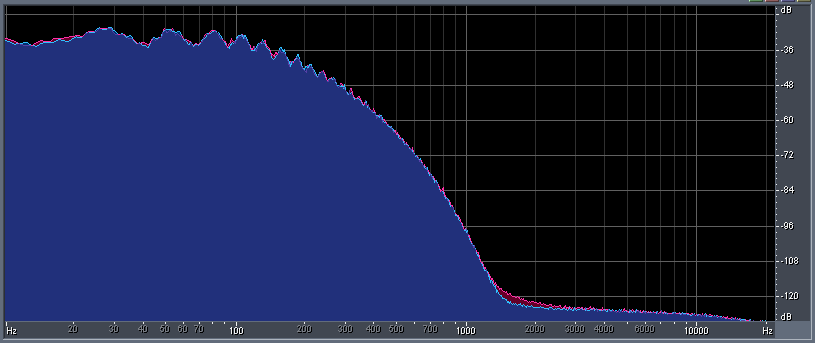Noise generation without randomness
78 views
Skip to first unread message
Keith Blackwell
Dec 14, 2015, 2:36:36 AM12/14/15
to Analog Box
Just playing around this weekend, I hooked up two sine wave
oscillators to modulate each other in both frequency and amplitude,
and then even used a filtered version of the output (of each) to
vary an extra bit of delay so it wouldn't just be constant 1024
samples. I was very surprised to get what seems like filtered
noise, despite not having used any randomness anywhere. There is,
actually, some tonal nature to it, but in certain frequency ranges
(especially very low frequency), I can't actually detect that with
my ears. Listen to this earthquakey-low-frequency noise:
The circuit is, of course, quite simple:

But by adjusting the range and center frequencies, you can get very different sounds out of it. I put another, much longer, output file on freesound that has variations in it. But never mind that. For the constant rumble linked above, the spectrum ended up looking like this (in Cool Edit Pro):

So, being unversed in most oscillator and noise generator techniques, I'm wondering if this is a well known or common trick? Or is it instead just an artifact of what is essentially pseudo-random sequences of numbers that result from quantization limits in the circuit?
Here's the circuit, in case anyone cares to play with it (it is quite easy to simplify or improve it).
The circuit is, of course, quite simple:
But by adjusting the range and center frequencies, you can get very different sounds out of it. I put another, much longer, output file on freesound that has variations in it. But never mind that. For the constant rumble linked above, the spectrum ended up looking like this (in Cool Edit Pro):

So, being unversed in most oscillator and noise generator techniques, I'm wondering if this is a well known or common trick? Or is it instead just an artifact of what is essentially pseudo-random sequences of numbers that result from quantization limits in the circuit?
Here's the circuit, in case anyone cares to play with it (it is quite easy to simplify or improve it).
Keith W Blackwell
Dec 14, 2015, 2:52:06 AM12/14/15
to Analog Box
By the way, I had an iframe embedded link to the freesound player in that original posting, but it doesn't work in my mail client, and the google groups web site seems to filter it out completely. Here are the url's to the sound pages (sorry for the inconvenience):
DeepNoiseLoop.wav (seamless loop of low frequency noise)
NoisyXModOscillators.wav (long demo with variations)
Saptarshee Clinics
Mar 14, 2024, 5:18:24 AM3/14/24
to Analog Box
Hi Kaith , Do you still use ABOX.
Keith W Blackwell
Apr 12, 2024, 12:38:30 PM4/12/24
to Analog Box
Sorry, I thought I finally got around to answering this about a week or so ago, but I don't see the reply here. I think it said something like, "Yes, occasionally, about as often as I check this email address for new messages". I'm not sure what is going wrong with that, but the simple answer is just "Yes". Why do you ask?
I don't use it every day, just once in a while. Sometimes I have some sound-generation idea in my mind and I think, "I should try that in Analog Box", and then another 5 hours later of dinking around in ABox, I can't even remember what the original thought was. Last night I decided to plug the "Harpsicord" voice from the official LIBRARY into a circuit I have -- as the 6 voices in a 6-voice stack being fed by a pentetonic sequencer that mostly moves each of a spread of 3 separate midi notes around by separate LFO's and picks from them in a kind of round-robin fashion. The output went through John Paul Burtell's EON (reverb subcircuit), and the impulsiveness of that harpsicord sound created a rather nasty set of distinct echos in EON, so I added a 6-stage sequence of all-pass filters in front of EON to smooth it all out, with prime numbers of samples on each all pass arranged with each subsequent stage having about 3 times the delay of the previous one (roughly), and with a blend of prior-stage's input verses prior-stage's output via a demuxer at the input of each subsequent stage all controlled by a shaping knob, and a low-pass and high-pass filter on the final feedback line that also added a few more blocks of delay (overkill, really). All that just to say that, yes, from time to time, I do use it. So that took about 1.5 hours of my time, just for entertainment, but it was because there was an internet outage in my neighborhood so I couldn't do anything online or watch any streaming videos. :-) And honestly, I don't dive in like that all that often anymore.
Reply all
Reply to author
Forward
0 new messages
